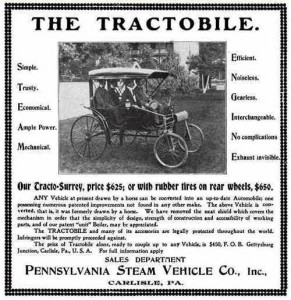In Beverly Rae Kimes’ book Pioneers, Engineers, and Scoundrels (SAE International, 2004) one of the recurring characters in the early chapters is E.J. Pennington. Born in Moores Hill, Indiana in 1858, Pennington was active in many areas that involved application for internal combustion
engines, including both motorcycles and cars. According to his obituary from the New York Times, he developed a series of fraudulent schemes using poor designs where “thousands invested their money in his visionary schemes and got nothing in return.” According to Kimes, he had developed quite an bad reputation by the turn of the century, something that did not faze him in the slightest. Whether because, or in spite of, his reputation,”he showed up in Carlisle, PA in 1900 with a real loser, The Tractobile.” (Kimes, The Standard Catalog of American Cars (1996), quoted in Early American Automobiles.com ) The Tractobile was built by Pennington’s Pennsylvania Steam Vehicle Company from either 1900 or 1901, to 1902. This was apparently business as usual for Pennington – his schemes rarely lasted more than a few years. The Tractobile was a mechanical replacement for a horse in a literal sense – it was a steam engine that could be attached to a normal carriage, thus converting the carriage into a sort of car; “The steam motor was connected to a removable frame built between two bicycle wheels with a tiller connected to the right wheel” (Kimes, quoted in Earlyamericanautomobiles.com).
An advertisment for the vehicle is below. Note the use of an acrostic to extoll the virtues of steam power. Also note the price – $450 for “the Tractobile… ready to couple up to any Vehicle” – $450 was cheap for a car at this time period, though there was significantly less mass to the Tractobile than to a full purpose built car. According to Kimes and Early American Automobiles.com, very few Tractobiles were ever built. There were none listed in the Carlisle car registry I examined at the Historical Society, which was disappointing. As best I can tell, Pennington’s Tractobile was a total flop and after 1902 he moved on to other schemes. I do not know how much he profited from the Tractobile, nor how many (if any) were produced or sold. I scanned through some antique car websites, and have been unable to find one for sale or preserved in a museum. One may yet exist somewhere, though hopefully it is not driven regularly. Pennington himself died from Meningitis in 1911 in Springfield, MA.
This story illustrates the same point that I made at the end of “Early Cars in Carlisle” – that Carlisle’s automotive history goes well beyond the shows that are put on every year. One of the best known con-men and engineering mind decided on Carlisle as a suitable place to try out his latest idea. This is indicative of two things. First, the people of Carlisle may have fallen for his scheme, something they should have known about given his sizable reputation. Secondly, and more importantly, Carlisle and the surrounding area was large enough, and important enough, with enough transportation hubs, that a new car company could set up with hope to profit. In other words, Carlisle was no small backwards town, but rather a place of growth that could contribute to the burgeoning automotive industry.
sources:
Kimes, Beverly Rae. Standard Catalog of American Cars, 1805-1942. 3rd ed. Iola, WI: Krause Publications, 1996. Quoted in Earlyamericanautomobiles.com.
Kimes, Beverly Rae. Pioneers, Engineers, and Scoundrels: The Dawn of the Automobile in America Warrendale, PA: SAE International, 2004.


